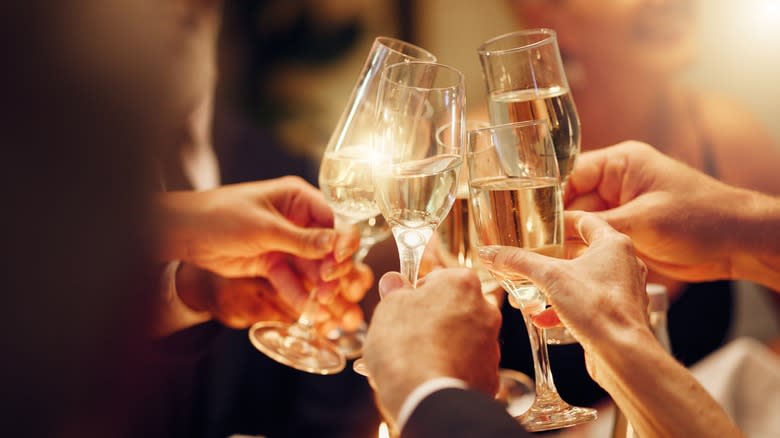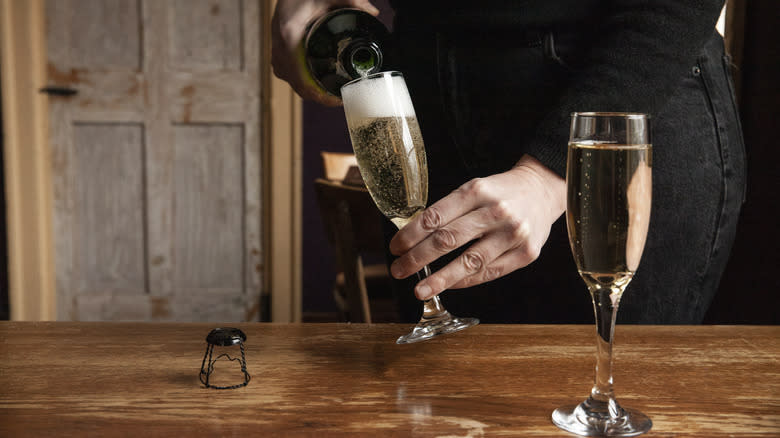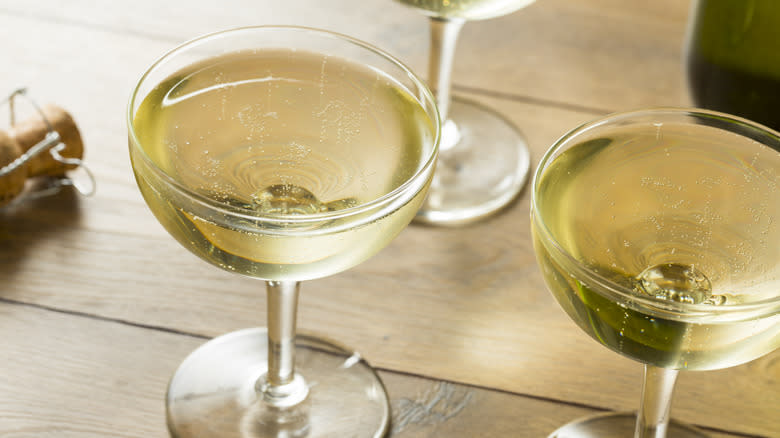The Simple Champagne Faux Pas You Need To Stop Making

Whether it's thanks to production methods like tank, classic, Charmat or otherwise, sparkling wine is always magic in a bottle. And no matter what behind the scenes decisions are made to ensure that liquid becomes the bubbly, effervescent product we all love to raise in a toast, it's also up to the drinker to bring it to the table in its best iteration.
Enjoying a glass of Champagne is one of life's simple pleasures, but if you're not careful, you might not get the best out of your bubbles. There's a very simple Champagne faux pas that could ruin your best sips. Fortunately, it couldn't be easier to avoid, if you take a few moments to familiarize yourself with how you should hold a wine glass. When it comes to sparkling wine like Champagne, if you're in the habit of holding the bowl of your flute rather than the stem, you could be warming up your beverage with your body heat, compromising the carbonation and causing it to go flat -- and that can kill any bubbly buzz.
Read more: 10 Of The Healthiest Beers You Can Drink
Why It's Important To Observe This Temperature Tip

Champagne's fizziness is a major part of its character, and that carbonation won't last forever -- which is why you want to enjoy your bubbly before it goes flat. There are a few things you can do to keep it from fading, though, and temperature plays a major role as cold helps keep the bubbles (CO2) in solution.
Remember that your body temperature is much higher than the ideal for your drinking fluid (the average temperature of a human hand can be somewhere between 82 and 90 degrees Fahrenheit). Holding the portion of the glass that contains the liquid can result in a transfer of that heat, resulting in the loss of carbonation.
While there is some debate about how significantly this will impact your wine's temperature during the time it takes you to enjoy it, there are other reasons that you'll want to reach for the stem instead -- including that your hand has its own aroma which could interfere with that of your bubbly. But it's best practice to store it at "cellar" temperature, around 55 to 60 degrees Fahrenheit, then chill down to serving temperature either in the fridge for a few hours or an ice bucket before it's time to pop the cork. If you start out with a fresh pour at a proper, cool temperature, you'll be more likely to keep the liquid lively for longer.
Other Factors For Your Bubbly Enjoyment

While there is no limit to the breadth of beautiful glasses out there, also keep in mind that the shape of the vessel will have an impact on your sparkling wine's effervescence, too. For example, the coupe glass -- a 1920s style that has become quite popular in recent years -- has a wide mouth. While that may not cause a problem for a still drink like a cocktail (a simple cosmopolitan, Bee's Knees, and Last Word are all good contenders for this type of glass), the increased surface area will cause your bubbles to escape more quickly.
A flute, by contrast, has a much smaller surface area and is also deeper. In this shape, the bubbles actually pull double duty, and help to aerate your Champagne as they rise from the bottom of the glass; the increased depth makes this process more effective, since bubbles will move through more of the liquid than they would in a shallow glass.
There are pros and cons to so many designs, but if you find a set of glasses that really speaks to you, simply keep your hands off the bulb so the Champagne will be at it's coldest temperature while you enjoy it. With this tip in mind, you'll be more likely to get the most from your favorite Champagne toast no matter what.
Read the original article on Daily Meal

